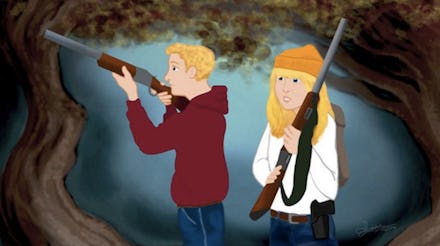The NRA Just Added Guns to Your Favorite Childhood Fairytales to Teach Us About "Safety"

So this is what they mean by "good guys with guns," then — children. In a new series published on NRA Family, author Amelia Hamilton addresses the problem of hyper-violent fairytale narratives by putting firearms in the hands of pint-sized protagonists. In Little Red Riding Hood (Has a Gun) and Hansel and Gretel (Have Guns), we learn that arming the right people (apparently, kids) makes for a lot less bloodshed in daily life.
What an inspiring message for our nation's youth.
Read more: This Gun Control Study Suggests a Clear Link Between Firearm Regulation and Gun Deaths
"Most of us probably grew up having fairly tales read to us as we drifted off to sleep," the editor's note on Little Red Riding Hood (Has a Gun) reads. "But how many times have you thought back and realized just how, well, grim some of them are? Did any of them ever make your rest a little bit uneasy?"
And certainly, anyone who's read the original Brothers Grimm version of Snow White knows that fairytales don't always make for charming bedtime stories. But the NRA goes a step further.
"Have you ever wondered what those same fairy tales might sound like if the hapless Red Riding Hoods, Hansels and Gretels had been taught about gun safety and how to use firearms?" the note continues.
As it happens, no — probably because of the association between gun-toting kids and accidental shootings. In 2015, at least 265 people were the accidental victims of armed minors. But Hamilton's tales present an entirely different picture of children and firearms. In both stories, the violence we know to expect never materializes.
Hansel and Gretel, for example, venture out into the woods on a hunting expedition intended to save their family from starvation. They're drawn to the witch's candy cottage by the shouts of two young, caged boys inside; because the witch is sleeping soundly, Hansel and Gretel are able to spring the prisoners and alert the authorities. The rifles they're carrying have no bearing on solving the actual crime.
Similarly, Little Red Riding Hood encounters the wolf en route to her grandmother's house, but because she — like Hansel and Gretel — is well trained in riflery, she doesn't even draw. Granny, however, is less discerning, moving immediately for her shotgun when the wolf comes to her door. She holds him there until Red arrives and ties him up. The huntsman later collects the wolf, and "they all lived safely ever after."
The firearms aren't what saves anyone from being eaten in the above scenarios. As Hamilton told NRA News' Cam Edwards on his radio show, Cam & Co., the moral of these stories is that people should learn caution.
"It's not just guns but just general safety," she said. "That they are avoiding all of these horrific situations that happen in fairy tales that are really very violent in the traditional tellings. If kids are taught safety in general, all of this could be avoided."
The "horrific situations" on which fairytales center are diverse, though. It's not necessarily hard to imagine how the narratives in each could change with the addition of guns, but one does have to ask why that's even relevant. As NPR put it, maybe Hamilton's stories will "inspire some other advocacy and lobbying groups to defang disturbing fairy tales," for example:
"Will the pharmaceutical industry take the bite out of Snow White's poisoned apple? Will PETA soothe the angst of the Boy Who Cried Wolf, when the townspeople realize the joys of an animal-free life and set loose their sheep? Will agribusiness harness Jack's beanstalk?"
Given those 265 people shot by children last year, we can only hope that these second amendment-friendly fairytales don't inspire the gun lobby to push for arming the nation's kids.